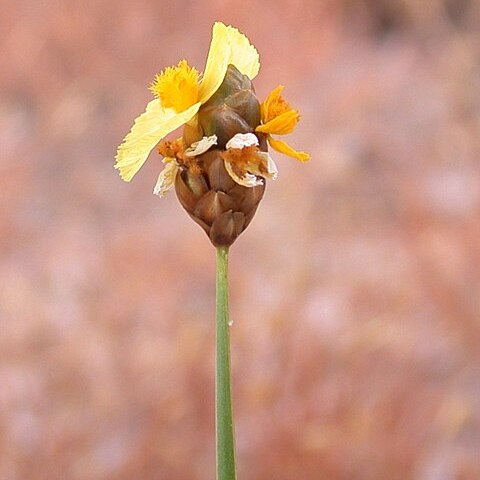Leaves (narrowly) linear, 3-25 cm by 1-2 mm, acute (to acuminate), often twisted, striate when dry, (sparsely) papillate at either side, sometimes restricted to the margin only in mature leaves; sheath 1-11 cm long with a scabrous keel or sometimes a scabrous keel. Peduncle subterete, (distinctly) compressed but sometimes terete in the basal part or with 2 narrow wings, twisted, 4-40(-60) cm by 1-1½ mm, sometimes subscabrous in the upper part, glabrous in the lower part, provided with a few prominent ribs in the upper part. Head ovoid to globose or ellipsoid, 3-10 by 2-8 mm. Basal bracts elliptic or suborbicular, 1-4 by 2-4 mm, obtuse, emarginate, papillate along the midrib or at the top only, with 2 descending nerves or 2 complete and 4 incomplete nerves; median bracts elliptic to orbicular or (broadly) obovate, 3-6 by 4-5 ½ mm, obtuse, with 4-6 (partly) complete or incomplete, sometimes branching, descending nerves and a narrow papillate triangle in the upper third, spinulose at the top or apex with a hollow papillate prominulous tooth, then entire or emarginate, margins membranous or entire to scarious. Lateral sepals curved, 3-5 by ½-2 mm, (sub)acute, crest narrow, coarsely serrate, wings unequal, tapering towards the base, sometimes with a few teeth in the apical part of the crest. Median sepal spathelliform, ca 3 mm long. Petals 3-9 mm long, limb obovate(-cuneate), 2-3½ by 1½-2 mm, margin crenulate, claw ca. 2 or 4-5 mm. Stamens ca ⅔-1½ mm, filaments ca 1/5 mm, abruptly narrowed at the top, anthers ½ — ¾ by ca ½ mm, sometimes deeply incised at either end, top and base of the cells obtuse; inner loculi of the thecae shorter than the outer ones, obtuse, connective membranously widened. Staminodes 2-forked, penicillate, ca ½-1 mm long. Ovary obovoid, 3-sided to 3-sulcate, 3-celled, 2-3 by 1-1½ mm. Style 3-fid, 2-3 mm long, sometimes with 2 broad membranes and a narrow wing decurrent along the ovary, branches ca ½ mm, capitate; stigmas leaf-like widened, united in a 3-sided infundibulum.
More
Herbs tufted. Leaf sheath 1.5--6 cm; leaf blade narrowly linear, 8--22 cm × 1--3 mm, striate when dry, margin sparsely papillose, apex acute to acuminate. Peduncle 5--35 cm × 1--1.5 mm, subterete. Spikes globose to ovoid, 6--13 × 6--11 mm; basal bracts elliptic, papillose along apical 1/2 of midvein, apex emarginate to obtuse; median bracts suborbicular to broadly obovate, 3--5 × 3--4 mm, apical 1/3 with a triangular, papillose patch, midvein dark brown, thickened, margin membranous, apex spinulose. Lateral sepals boat-shaped, 3.5--4.5 × ca. 1.5 mm, membranous, keel narrow, coarsely serrulate, apex subacute; median sepal hooded, ca. 3.5 mm. Petals yellow; limb obovate, 2.5--3.5 mm; claw 3--4 mm. Stamens 0.9--1.3 mm; anthers broadly ovate; inner locule shorter than outer one; connective widened, apex obtuse. Staminodes 2-brachiate, shorter than stamens. Ovary obovoid. Style 1.2--2 mm; stigma capitate. Capsule ovoid to ellipsoid, 4--5 mm. Seeds 0.4--0.5 mm. Fl. Sep--Nov, fr. Oct--Dec.
A tufted annual herb. It grows 20-40 cm high. The leaf sheath is 2-6 cm long. The leaves are narrow and 8-22 cm long by 1-3 mm wide. The flower stalk is 5-35 cm long by 1-2 mm wide. The flower spikes are oval and 6-13 mm long by 6-11 mm wide. The flowers are yellow.


